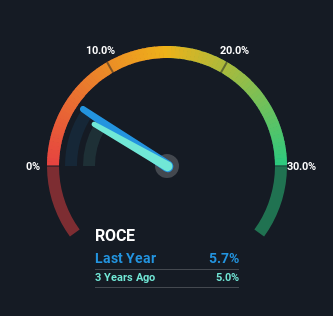- Japan
- /
- Trade Distributors
- /
- TSE:4690
The Returns On Capital At Nippon Pallet Pool (TSE:4690) Don't Inspire Confidence
What financial metrics can indicate to us that a company is maturing or even in decline? Businesses in decline often have two underlying trends, firstly, a declining return on capital employed (ROCE) and a declining base of capital employed. Basically the company is earning less on its investments and it is also reducing its total assets. So after glancing at the trends within Nippon Pallet Pool (TSE:4690), we weren't too hopeful.
Understanding Return On Capital Employed (ROCE)
For those who don't know, ROCE is a measure of a company's yearly pre-tax profit (its return), relative to the capital employed in the business. Analysts use this formula to calculate it for Nippon Pallet Pool:
Return on Capital Employed = Earnings Before Interest and Tax (EBIT) ÷ (Total Assets - Current Liabilities)
0.057 = JP¥440m ÷ (JP¥10b - JP¥2.6b) (Based on the trailing twelve months to December 2024).
Thus, Nippon Pallet Pool has an ROCE of 5.7%. In absolute terms, that's a low return and it also under-performs the Trade Distributors industry average of 7.2%.
View our latest analysis for Nippon Pallet Pool

While the past is not representative of the future, it can be helpful to know how a company has performed historically, which is why we have this chart above. If you want to delve into the historical earnings , check out these free graphs detailing revenue and cash flow performance of Nippon Pallet Pool.
What Does the ROCE Trend For Nippon Pallet Pool Tell Us?
In terms of Nippon Pallet Pool's historical ROCE movements, the trend doesn't inspire confidence. About five years ago, returns on capital were 7.3%, however they're now substantially lower than that as we saw above. Meanwhile, capital employed in the business has stayed roughly the flat over the period. This combination can be indicative of a mature business that still has areas to deploy capital, but the returns received aren't as high due potentially to new competition or smaller margins. So because these trends aren't typically conducive to creating a multi-bagger, we wouldn't hold our breath on Nippon Pallet Pool becoming one if things continue as they have.
The Bottom Line
In the end, the trend of lower returns on the same amount of capital isn't typically an indication that we're looking at a growth stock. But investors must be expecting an improvement of sorts because over the last five yearsthe stock has delivered a respectable 53% return. Regardless, we don't feel too comfortable with the fundamentals so we'd be steering clear of this stock for now.
One more thing, we've spotted 3 warning signs facing Nippon Pallet Pool that you might find interesting.
While Nippon Pallet Pool isn't earning the highest return, check out this free list of companies that are earning high returns on equity with solid balance sheets.
Valuation is complex, but we're here to simplify it.
Discover if Nippon Pallet Pool might be undervalued or overvalued with our detailed analysis, featuring fair value estimates, potential risks, dividends, insider trades, and its financial condition.
Access Free AnalysisHave feedback on this article? Concerned about the content? Get in touch with us directly. Alternatively, email editorial-team (at) simplywallst.com.
This article by Simply Wall St is general in nature. We provide commentary based on historical data and analyst forecasts only using an unbiased methodology and our articles are not intended to be financial advice. It does not constitute a recommendation to buy or sell any stock, and does not take account of your objectives, or your financial situation. We aim to bring you long-term focused analysis driven by fundamental data. Note that our analysis may not factor in the latest price-sensitive company announcements or qualitative material. Simply Wall St has no position in any stocks mentioned.
About TSE:4690
Nippon Pallet Pool
Engages in the rental of a pallet pool system that enables corporate activities and supports physical distribution in Japan.
Excellent balance sheet second-rate dividend payer.
Market Insights
Community Narratives



